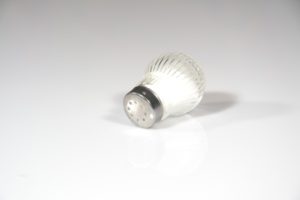Do you ever have a friend that acts a little salty? Maybe it is because they eat too much salt! Okay, okay…enough with the corny jokes. In all reality, many Americans actually do consume too much sodium – even if they don’t act salty. The 2015-2020 Dietary Guidelines for Americans recommends that adults and children ages 14 years and older consume less than 2,300 milligrams of sodium per day. On average, Americans actually consume 3,440 milligrams of sodium per day.
Because of the linear dose-response relationship between sodium intake and blood pressure, every incremental decrease in sodium intake that moves toward recommended limits is encouraged.”
– 2015-2020 Dietary Guidelines for Americans
I was recently asked: “Is table salt or sea salt healthier for us?” The response I provided was that some varieties of sea salt may have less sodium per equal volume of table salt. This is because the sea salt crystals are larger, so fewer crystals would fit in the unit of measure (ex. teaspoon or tablespoon). Different varieties of sea salt have different amounts of sodium, so it actually comes down to reading the Nutrition Facts Panel on each individual item though.
I would caution that you should not start using excess amounts of sea salt just because it might have a little less sodium than table salt. Sometimes, we might consume a larger portion than usual of a given food if we believe it to be healthier. For example, if ¼ teaspoon of  table salt has 575 milligrams of sodium and ¼ teaspoon of a certain variety of sea salt has 450 milligrams of sodium, but you actually used ½ teaspoon of sea salt (since you knew it had less sodium), you wouldn’t be consuming any less sodium! In fact, you’d be consuming 900 milligrams of sodium instead of 575 milligrams. Too much of a “slightly healthier” option isn’t always a good thing! It’s kind of like thinking, “I can have another brownie because the package says it’s low-fat.” While the brownie might be tasty, that might not be the best rule to follow.
table salt has 575 milligrams of sodium and ¼ teaspoon of a certain variety of sea salt has 450 milligrams of sodium, but you actually used ½ teaspoon of sea salt (since you knew it had less sodium), you wouldn’t be consuming any less sodium! In fact, you’d be consuming 900 milligrams of sodium instead of 575 milligrams. Too much of a “slightly healthier” option isn’t always a good thing! It’s kind of like thinking, “I can have another brownie because the package says it’s low-fat.” While the brownie might be tasty, that might not be the best rule to follow.
Similarly, I wouldn’t purchase a product just because it contains sea salt. The product may contain just as much – or maybe more – sodium than the product made with table salt. Food companies are really smart. They put claims on packages to get people to think a particular food is more nutritious. However, it isn’t always! There is a certain company that makes French fries with sea salt instead of table salt. I remember hearing someone say that they were going to purchase those fries because the fries were “healthy” fo r them. It took all my power to refrain from screaming “No, sea salt does not magically make French fries healthy!”
r them. It took all my power to refrain from screaming “No, sea salt does not magically make French fries healthy!”
You may be wondering what the hype is all about then. Some people really enjoy sea salt because of its taste, texture, or color. Chefs may prefer it in cooking because of the crunchy texture and stronger flavor. It goes through minimal processing and contains small levels of minerals (including magnesium, potassium, and calcium) albeit in trace amounts.
Since many foods are already filled with sodium, maybe just follow the superstition of throwing salt over your shoulder for good luck instead of sprinkling it on your food. Of course, that could get a little messy….

